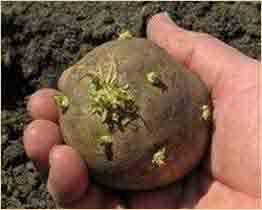Potato Storage. How to store potatoes long term?
LinkExchange SearchMe WhatWeDo AboutUs Sitemap Next page The risks of storing crops that are not fit for storage

In order to successfully store potatoes, the storage facility must be sufficiently equipped to:
How are potatoes stored?

Potatoes en route to the storage facility.
The processes required to store potatoes properly.
Within the storage facility, potatoes undergo the following processes:
- Drying
- Cooling or heating
- Curing
- Storage proper
Each of these processes are controlled by the AgroVent systems BV Multiserver.
The potato drying process
The aim of drying potatoes is:
To remove outer moisture from the potato, whilst retaining inner moisture.

Potato humidification, during the drying process!

A dehydrated potato which has been improperly dried.
Potato drying is a very delicate process, because the aim is not to dry the inside of the potato, but just the skin and the dirt stuck to it.
Please note: It is better to store potatoes which are still slightly dirty from the field. This fine layer of earth will protect them. Potatoes are brushed when they leave the storage facility, not when they enter.
It is better to dry them at approximately 25° Celsius, and at approximately 85% relative humidity. In extreme situations, the air needs to be humidified during the drying process, to avoid results like the potato in the photo to the right.
Please note: It is better to store potatoes which are still slightly dirty from the field. This fine layer of earth will protect them. Potatoes are brushed when they leave the storage facility, not when they enter.
We call the potato "dry" when it no longer has visible moisture, and feels cool, rather than moist.
Curing potatoes
Potato curing is a process in which the potatoes are kept for between 7 and 10 days at 15° Celsius, with around 95% relative humidity.
In these conditions, the potatoes have the chance to self-cure any small wounds in their skin which may have occurred during harvest, transport and handling. This curing process is carried out to improve their storage capacity: The less open wounds they have, the lower the risk of infection during storage.
In order to cure them effectively, a well-controlled humidification system is essential.
A word of warning
If there is any chance of a Phytophthora (late blight), the curing process must be interrupted and the potatoes must be moved as quickly as possible to somewhere with their required storage temperature.
The process of lowering the temperature of potatoes
Once they are dried and cured, the process of lowering the storage temperature of the potatoes begins. This must be done in such a way that the potatoes lose as little weight as possible. To achieve this, the temperature must be lowered gradually.
It can be lowered by no more than 0.3 to 0.5° Celsius per day.
Very important::
Do not, under any circumstances, increase the temperature during this process. If a potato is cooled down, it "thinks" that winter has arrived, but if it suddenly warmed, its germination mechanism awakens, because the potato "thinks" that spring has come around again.

Multiserver
The air used for refrigeration must have a sufficient cooling capacity, but the temperature of the cooling air must not be more than 2° Celsius colder than the potatoes. During this entire process, the air that is used must be moist enough (close to 85% relative humidity).
This potato cooling process, during which a delicate balance of doors, condensers and humidifiers constantly monitor the temperatures and humidity, all fully automated by the Multiserver.
The process of storing potatoes and the different temperatures during storage
Storage itself is, in fact, the easiest thing to do.
It involves constantly keeping the potatoes: at the right temperature for their final use; at 90% relative humidity; at a regularly checked CO2 level; and in total darkness.
All of this also requires using the turbines as little as possible.
The final destination of the potato determines its storage temperature.
The different cold storage temperatures for potatoes depending on the final destination of the potato.
Potatoes to produce
crisps (chips)

Stored between 7 and 10° C.
Potatoes to produce
chips (fries)

Stored between 5 and 6° C.
Potatoes for
fresh consumption

Stored between 4 and 7° C.
Potatoes stored for
Seed potatoes

Stored between 4 and 5° C.
Potatoes to produce
starch and flakes

Stored between 4 and 5° C.
When potatoes are chilled to below 5 to 8° Celsius, their starches become sugars, known as reducing sugars.
These reducing sugars are the main cause of the brown discolouration, bitter taste and limpness of chips and fries if the potatoes are reheated incorrectly after storage.
This is known as the Maillard reaction.
The Maillard reaction is worth knowing about, because it can help to avoid poor quality crisps and chips.
The process of increasing the temperature of potatoes at the end of storage.
Once the storage period is over, the temperature of the potatoes must be increased, for two reasons:
- To give the reducing sugars the opportunity to reconstitute the starches and avoid the Maillard reaction.
- To avoid produce condensation when leaving the storage facility
This process of increasing the temperature of the potatoes at the end of the storage period is almost the opposite of the process of decreasing their temperature.
Once again, this process is fully automated by the Multiserver.
Potato germination during storage.
A word of warning
Potatoes stored below 5° Celsius do not sprout.
Potatoes stored above 5° Celsius do sprout.
The higher the storage temperature, the more chance of germination, which creates serious problems resulting in significant losses.
There are a number of commercial products in the form of gases and powders which can combat tuber sprouting.
To find out more information, please visit:
Most information on this topic is in English or Dutch.
1. Dry the potatoes, to remove their external moisture.
2. Cure the potatoes at a relatively high temperature, so that any wounds suffered during harvest and transport are cured. That said, if any potatoes are infected with Phytophthora, they must not be cured in order to prevent the blight from spreading.
3. Once they are cured, the temperature of the potatoes must be gently lowered to the final required storage temperature, which is between 4 and 10 degrees, depending on the final destination of the potatoes.
4. Keep the potatoes at a constant temperature, with around 90% relative humidity, in total darkness and with monitored CO2 levels, for months at a time.
5. In addition, before their removal from the cold store, the potatoes must be gradually returned to room temperature, to avoid condensation and the Maillard reaction.
To mechanise your post harvest processes:
contact us:
Telephone:
+1 239 3002374
or use our (preferable)
our contact form
Address: Farm San Isidro, Volcán, Panama.

